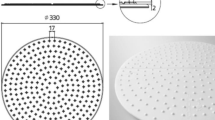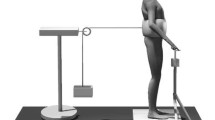Abstract
In this study, we compared the ability of young (n=10, 19–32 years) and older subjects (n=35, 60–86 years) to use fingertip contact as a balance aid during quiet stance under various conditions to determine whether aging would influence contact strategies. Experimental trials (duration, 60 s) included two visual conditions (vision; no vision), three fingertip contact conditions (no touch; smooth touch; rough touch) and two support surface conditions (firm; foam). In trials with contact, participants were required to maintain a light contact with their right index fingertip on an instrumented touch-plate. Subjects were not constrained to exert minimal contact force, although they were aware that the touch-plate was not designed for physical support. From displacements of the centre of foot pressure (COP), mean sway amplitude (MSA) was computed in the anterior-posterior (COPAP) and medio-lateral (COPML) directions. Subjective estimates of stability were also obtained by asking participants to rate perceived stability on a visual analog scale in each condition. Mean normal force (F N ) and mean resultant tangential force (F TAN) were computed from contact force data applied on the touch plate. In both age groups, touch conditions had a substantial effect on MSA in the AP direction under both support surface conditions, with reductions averaging between 40–55% when touch was allowed. Reductions in the ML direction, though less important (8–12% on average), were nevertheless highly significant, especially in the older subjects when standing on the foam. In the two groups, vision and texture had only marginal impact on MSA computed on both support surfaces. Contrasting with sway measurements, stability ratings were highly influenced by visual conditions in both age groups. Only in conditions of deficient support (foam surface) and absent vision did the perceived effect of touch exceed that of vision. Age had a major impact, however, on contact forces deployed during trials with touch. While individuals in the young group typically produced forces of <1 N (mean F N , 0.32±0.15 N) to achieve postural stabilization, older subjects tended to use higher, though not too excessive, contact forces (mean F N , 1.21±0.75 N) under the same conditions. From these findings, we conclude that the ability to use contact cues from the fingertip as a source of sensory information to improve postural stability is largely preserved in healthy older adults. The increase in contact force deployed by older individuals to achieve postural stabilization is interpreted as a compensatory strategy to help overcome age-related loss in tactile sensation, an issue that will be further addressed in a companion paper.






Similar content being viewed by others
References
Bergin PS, Bronstein AM, Murray NM, Sancovic S, Zeppenfeld DK (1995) Body sway and vibration perception thresholds in normal aging and in patients with polyneuropathy. J Neurol Neurosurg Psychiatry 58:335–340
Birznieks I, Jenmalm P, Goodwin AW, Johansson RS (2001) Encoding of direction of fingertip forces by human tactile afferents. J Neurosci 21:8222–8237
Borel L, Le Goff B, Charade O, Berthoz A (1994) Gaze strategies during linear motion in head-free humans. J Neurophysiol 72:2451–2466
Cadoret G, Smith AM (1996) Friction, not texture, dictates grip forces used during object manipulation. J Neurophysiol 75:1963–1969
Carpenter MG, Frank JS, Winter DA, Peysar GW (2001) Sampling duration effects on centre of pressure summary measures. Gait Posture 13:35–40
Clapp S, Wing AM (1999) Light touch contribution to balance in normal bipedal stance. Exp Brain Res 125:521–524
Cole KJ, Rotella DL (2001) Old age affects fingertip forces when restraining an unpredictably loaded object. Exp Brain Res 136:535–542
Cole KJ, Rotella DL, Harper JG (1999) Mechanisms for age-related changes of fingertip forces during precision gripping and lifting in adults. J Neurosci 19:3238–3247
Desrosiers J, Hebert R, Bravo G, Dutil E (1996) Hand sensibility of healthy older people. J Am Geriatr Soc 44:974–978
Dickstein R, Shupert CL, Horak FB (2001) Fingertip touch improves postural stability in patients with peripheral neuropathy. Gait Posture 14:238–247
Fernie GR, Gryfe CI, Holliday PJ, Llewellyn A (1982) The relationship of postural sway in standing to the incidence of falls in geriatric subjects. Age Ageing 11:11–16
Gilsing MG, Van den Bosch CG, Lee SG, Ashton-Miller JA, Alexander NB, Schultz AB, Ericson WA (1995) Association of age with the threshold for detecting ankle inversion and eversion in upright stance. Age Ageing 24:58–66
Holden M, Ventura J, Lackner JR (1994) Stabilization of posture by precision contact of the index finger. J Vestib Res 4:285–301
Jeka JJ (1997) Light touch contact as a balance aid. Phys Ther 77:476–487
Jeka JJ, Lackner JR (1994) Fingertip contact influences human postural control. Exp Brain Res 100:495–502
Jeka JJ, Lackner JR (1995) The role of haptic cues from rough and slippery surfaces in human postural control. Exp Brain Res 103:267–276
Johnson KO (2001) The roles and functions of cutaneous mechanoreceptors. Curr Opin Neurobiol 11:455–461
Kenshalo DR Sr (1986) Somesthetic sensitivity in young and elderly humans. J Gerontol 41:732–742
Kinoshita H, Francis PR (1996) A comparison of prehension force control in young and elderly individuals. Eur J Appl Physiol Occup Physiol 74:450–460
Krishnamoorthy V, Slijper H, Latash ML (2002) Effects of different types of light touch on postural sway. Exp Brain Res 147:71–79
Lackner JR, DiZio PA (2000) Aspects of body self-calibration. Trends Cogn Sci 4:279–288
Lackner JR, DiZio P, Jeka J, Horak F, Krebs D, Rabin E (1999) Precision contact of the fingertip reduces postural sway of individuals with bilateral vestibular loss. Exp Brain Res 126:459–466
Lackner JR, Rabin E, DiZio P (2000) Fingertip contact suppresses the destabilizing influence of leg muscle vibration. J Neurophysiol 84:2217–2224
Lackner JR, Rabin E, DiZio P (2001) Stabilization of posture by precision touch of the index finger with rigid and flexible filaments. Exp Brain Res 139:454–464
Lederman SJ (1974) Tactile roughness of grooved surfaces: the touching process and effects of macro- and microsurface structure. Percept Psychophys 16:385–395
Lederman SJ (1982) The perception of texture by touch. In: Schiff W (ed) Tactual perception: A source book. Cambridge University Press, Cambridge, pp 130–167
Maki BE, McIlroy WE (1996) Postural control in the older adult. Clin Geriatr Med 12:635–658
Maki BE, McIlroy WE (1997) The role of limb movements in maintaining upright stance: the “change-in-support” strategy. Phys Ther 77:488–507
Maki BE, Holliday PJ, Fernie GR (1990) Aging and postural control. A comparison of spontaneous- and induced-sway balance tests. J Am Geriatr Soc 38:1–9
Mireault AC, Dessureault L, Tremblay F, Sveistrup H (2002) Influences of light fingertip contact on balance during bipedal stance in younger and older adults. In: Kollmitzer J, Bijak M (eds) XIVth Congress of the International Society of Electrophysiology and Kinesiology, Department of Biomechanical Engineering and Physics, University of Vienna, Vienna, Austria, pp 379–380
Nashner LM, Shupert CL, Horak FB, Black FO (1989) Organization of posture controls: an analysis of sensory and mechanical constraints. Prog Brain Res 80:411–418; discussion 395–417
Rabin E, Bortolami SB, DiZio P, Lackner JR (1999) Haptic stabilization of posture: changes in arm proprioception and cutaneous feedback for different arm orientations. J Neurophysiol 82:3541–3549
Resnick HE, Vinik AI, Schwartz AV, Leveille SG, Brancati FL, Balfour J, Guralnik JM (2000) Independent effects of peripheral nerve dysfunction on lower-extremity physical function in old age: the Women’s Health and Aging Study. Diabet Care 23:1642–1647
Resnick HE, Vinik AI, Heimovitz HK, Brancati FL, Guralnik JM (2001) Age 85+ years accelerates large-fiber peripheral nerve dysfunction and diabetes contributes even in the oldest-old: the Women’s Health and Aging Study. J Gerontol A Biol Sci Med Sci 56:M25–31
Riley MA, Stoffregen TA, Grocki MJ, Turvey MT (1999) Postural stabilization for the control of touching. Hum Mov Sci 18:795–817
Sathian K, Goodwin AW, John KT, Darian-Smith I (1989) Perceived roughness of a grating: correlation with responses of mechanoreceptive afferents innervating the monkey’s fingerpad. J Neurosci 9:1273–1279
Schieppati M, Tacchini E, Nardone A, Tarantola J, Corna S (1999) Subjective perception of body sway. J Neurol Neurosurg Psychiatry 66:313–322
Smith AM, Chapman CE, Deslandes M, Langlais JS, Thibodeau MP (2002a) Role of friction and tangential force variation in the subjective scaling of tactile roughness. Exp Brain Res 144:211–223
Smith AM, Gosselin G, Houde B (2002b) Deployment of fingertip forces in tactile exploration. Exp Brain Res 147:209–218
Stevens JC (1992) Aging and spatial acuity of touch. J Gerontol 47:35–40
Stevens JC, Choo KK (1996) Spatial acuity of the body surface over the life span. Somatosens Mot Res 13:153–166
Stevens JC, Patterson MQ (1995) Dimensions of spatial acuity in the touch sense: changes over the life span. Somatosens Mot Res 12:29–47
Takei Y, Grasso R, Berthoz A (1996) Quantitative analysis of human walking trajectory on a circular path in darkness. Brain Res Bull 40:491–495
Tremblay F, Cuenco A, Backman A, Vant K, Wassef M-A (2000) Assessment of spatial acuity at the fingertip with grating (JVP) domes: Validity for use in an elderly population. Somatosens Mot Res 17:61–66
Tremblay F, Mireault AC, Letourneau J, Pierrat A, Bourrassa S (2002) Tactile perception and manual dexterity in computer users. Somatosens Mot Res 19:101–108
Verrillo RT (1979) Change in vibrotactile thresholds as a function of age. Sens Processes 3:49–59
Wolfson L, Judge J, Whipple R, King M (1995) Strength is a major factor in balance, gait, and the occurrence of falls. J Gerontol A Biol Sci Med Sci 50 Spec No: 64–67
Woollacott MH, Shumway-Cook A, Nashner LM (1986) Aging and posture control: changes in sensory organization and muscular coordination. Int J Aging Hum Dev 23:97–114
Acknowledgements
The authors wish to thank all participants for their time and patience during testing. A special thanks to Club “60” Vanier for their help with the recruitment of participants. Parts of this work served for the partial fulfillment of the MA in Human Kinetics of A.C. Mireault. A.C. Mireault was supported by an Ontario Graduate Studies scholarship. H. Manning and L. Dessureault participated in this project through undergraduate Student Research Awards from the Natural Sciences & Engineering Research Council (NSERC) of Canada. This project was supported by grant from NSERC (Canada) to F. Tremblay. H. Sveistrup is supported by NSERC, Canada, and is a Career Scientist of the Ministry of Health and Long-term Care, Ontario.
Author information
Authors and Affiliations
Corresponding author
Rights and permissions
About this article
Cite this article
Tremblay, F., Mireault, AC., Dessureault, L. et al. Postural stabilization from fingertip contact: I. Variations in sway attenuation, perceived stability and contact forces with aging. Exp Brain Res 157, 275–285 (2004). https://doi.org/10.1007/s00221-004-1830-4
Received:
Accepted:
Published:
Issue Date:
DOI: https://doi.org/10.1007/s00221-004-1830-4




